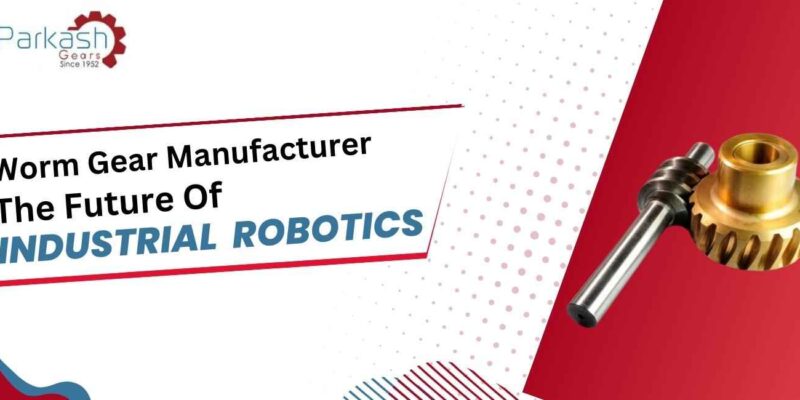
Worm Gear Manufacturer: The Future Of Industrial Robotics
Gear manufacturing is a crucial element in the world of industrial robotics. And when it comes to efficiency, durability, and precision, worm gears have been leading the way. Worm gear manufacturers play a vital role in developing high-quality gears that enable robots to perform complex tasks with utmost accuracy. In this blog post, we will explore the benefits of worm gear manufacturing, discuss different types of worm gears, weigh their pros and cons, and delve into the fascinating future of this innovative technology. So buckle up as we take you on an exciting journey through the world of worm gears!
The Benefits of Worm Gear Manufacturing
Worm gear manufacturing offers a multitude of benefits that make it an ideal choice for various industrial applications. Worm gears provide excellent torque multiplication and high reduction ratios, allowing robots to generate significant power while maintaining compact sizes. This is particularly advantageous in robotic systems where space is limited.
Additionally, worm gears exhibit exceptional shock load resistance and can withstand heavy loads without compromising their performance. This makes them suitable for demanding environments where robots need to handle rigorous tasks or operate under extreme conditions.
Another key advantage of worm gear manufacturing lies in its efficiency. Worm gears have high energy transmission capabilities due to their unique design, resulting in minimal power loss during operation. This means that robots equipped with worm gears can optimize energy consumption and maximize overall system productivity.
Furthermore, worm gears offer smooth and quiet operation, making them perfect for applications requiring low noise levels or those involving close human interaction. Their precision engineering ensures precise positioning control, enabling robots to execute intricate movements with accuracy and reliability.
The durability of worm gears cannot be overlooked. With proper lubrication and maintenance practices, these gears have a long lifespan and require minimal upkeep compared to other alternatives available in the market.
The Different Types of Worm Gears
Worm gears are widely used in various industries due to their unique design and functionality. They offer a high gear ratio, allowing for increased torque output while maintaining a compact size. But did you know that there are different types of worm gears available? Let’s explore some of these variations.
One type is the single-start worm gear, which has only one thread on its shaft. This configuration provides a higher gear ratio and smoother operation compared to multi-start worm gears. On the other hand, multi-start worm gears have multiple threads on their shafts, allowing for faster speed reduction but with slightly lower efficiency.
Another variation is the double enveloping worm gear, which features curved teeth instead of straight ones. This design ensures better contact between the teeth of the gear and the worm, resulting in improved load distribution and higher efficiency.
Additionally, there are also non-circular or elliptical-shaped worm gears that provide variable speed ratios throughout each revolution. These gears find applications in specialized machinery where precise control over speed variations is necessary.
Each type of worm gear offers distinct advantages depending on the specific requirements of an application. It’s crucial to consider factors such as load capacity, efficiency, space constraints, and desired output when selecting the right type for your needs.
The Pros and Cons of Worm Gears
Worm gears, like any other mechanical component, have their own set of advantages and disadvantages. Let’s take a closer look at the pros and cons of worm gears.
One of the main benefits of worm gear manufacturing is its high reduction ratio. This means that a small input rotation can result in a large output rotation, making it ideal for applications where precision control is required. Additionally, worm gears have excellent shock load resistance, which makes them suitable for heavy-duty industrial operations.
Another advantage is the self-locking feature of worm gears. Due to their unique design, they are capable of preventing back driving or reverse motion without needing additional braking mechanisms. This characteristic makes them reliable and safe in applications where holding power is crucial.
On the downside, one common drawback of worm gears is their lower efficiency compared to other types of gearing systems. The sliding action between the teeth results in higher frictional losses and heat generation during operation. Consequently, this can lead to reduced overall efficiency and increased energy consumption.
Additionally, another limitation is the potential for wear and tear on both the gear teeth and bearings due to constant contact pressure. Regular maintenance such as lubrication becomes necessary to ensure optimal performance and longevity.
Despite these drawbacks, advancements in material science and manufacturing techniques are continuously improving the durability and efficiency characteristics of worm gears. As a result, they remain an essential component in industrial robotics systems.
The Future of Worm Gears
As technology continues to advance at a rapid pace, the future of worm gears looks promising. These crucial components play a vital role in various industries, including automotive, aerospace, and robotics. With advancements in materials and manufacturing techniques, worm gears are set to become even more efficient and reliable.
One area that holds great potential for the future of worm gears is robotics. As robots become increasingly prevalent in industrial settings, the demand for high-performance gear systems will continue to rise. Worm gears offer several advantages in robotic applications, such as compact design and high torque transmission capabilities.
Additionally, with the advent of Industry 4.0 and the Internet of Things (IoT), there is an increasing need for smart gear systems that can provide real-time data on performance and maintenance requirements. The integration of sensors into worm gear assemblies can enable predictive maintenance practices, reducing downtime and optimizing efficiency.
Another exciting development on the horizon is the use of advanced materials in worm gear manufacturing. Traditional materials like steel are being replaced by lightweight alloys with superior strength properties. This not only reduces weight but also improves overall system performance.
Furthermore, advancements in 3D printing technology have opened up new possibilities for customized worm gear designs tailored to specific application requirements. This flexibility allows manufacturers to optimize gearing solutions based on factors such as load capacity, speed ratio, and noise reduction. Overall, the future of worm gears looks promising. With continued innovation and development, these essential components are set to play an even more integral role in the advancement of industrial robotics.
Conclusion
As we look toward the future of industrial robotics, worm gears will undoubtedly play a significant role in driving innovation and efficiency. With their unique design and numerous benefits, worm gears have become an essential component in various industries.
From their ability to provide high gear ratios and torque multiplication to their compact size and self-locking feature, worm gears offer unparalleled advantages compared to other types of gearing systems. This makes them highly sought after by manufacturers across the globe.
In India, Parkash Industrial Gears has emerged as a leading gear manufacturer specializing in worm gears. Their commitment to quality and advanced manufacturing techniques has made them a trusted partner for businesses looking for reliable and efficient gear solutions.
With advancements in technology such as automation, artificial intelligence, and IoT revolutionizing industrial processes, the demand for precise motion control is only going to increase. Worm gears are poised to meet this demand with their ability to deliver smooth operation, accurate positioning control, and low noise levels.
However, it’s important to note that like any other technology or product, worm gears have both pros and cons. While they excel in certain applications where precision motion control is required, they may not be suitable for high-speed or heavy-load operations due to potential limitations such as lower efficiency and higher frictional losses.
Nevertheless, Worm Gear Manufacturers continue to work tirelessly towards improving these aspects through research & development efforts. As a result, we can expect even more efficient, smaller & quieter Worm Gears to be developed which would further expand the possibilities of using them across industries.

 FSC India.
FSC India.
This Post Has 0 Comments